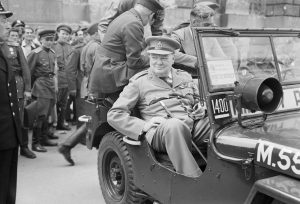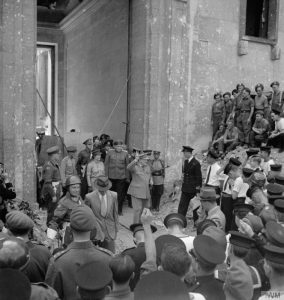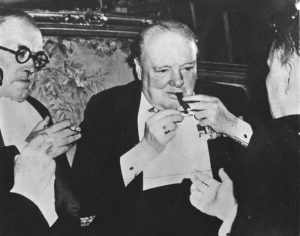
Finest Hour 171
Scapa Flow: The Churchill Barriers
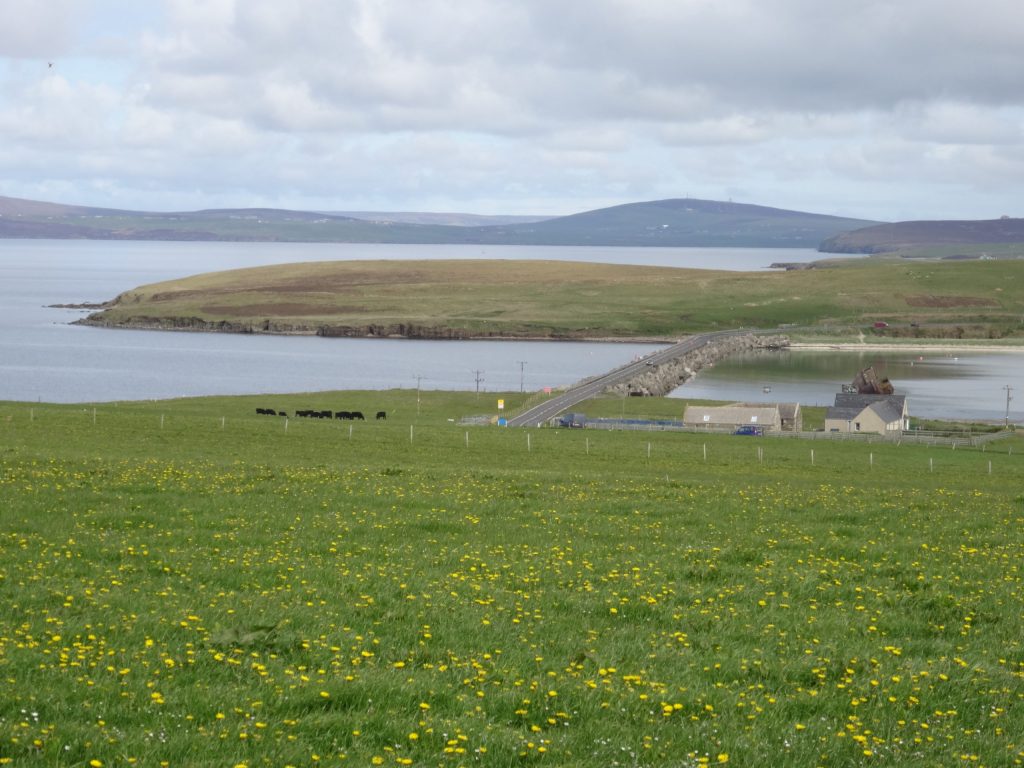
March 13, 2016
Finest Hour 171, Winter 2016
Page 22
By Terry Reardon
In the first volume of his Second World War memoirs, Winston Churchill published the following account based on a German report:
At 01.30 on October 14, 1939, H.M.S. Royal Oak, lying at anchor in Scapa Flow, was torpedoed by U.47 (Lieutenant Prien). The operation had been carefully planned by Admiral Doenitz himself, the Flag Officer (Submarines). Prien left Kiel on October 8…course N.N.W., Scapa Flow….The boat crept steadily closer to Holm Sound, the eastern approach to Scapa Flow. Unfortunate it was [for the British] that these channels had not been completely blocked. A narrow passage lay open between two sunken ships. With great skill Prien steered through the swirling waters….Then suddenly the whole bay opened out. Kirk Sound was passed. They were in. There under the land to the north could be seen the great shadow of a battleship lying on the water, with the great mast rising above it like a piece of filigree on a black cloth. Near, nearer—all tubes clear—no alarm, no sound but the lap of the water, the low hiss of air pressure and the sharp click of a tube lever. Los! [Fire!]—five seconds—ten seconds—twenty seconds. Then came a shattering explosion, and a great pillar of water rose in the darkness. Prien waited some minutes to fire another salvo. Tubes ready. Fire! The torpedoes hit amidships, and there followed a series of crashing explosions. H.M.S. Royal Oak sank, with the loss of 786 officers and men…. U.47 crept quietly away back through the gap.1

Three days later, as Churchill was reporting the tragedy to the House of Commons, Lieutenant Prien and his crew were sailing into their home base at the North Sea port of Wilhelmshaven. They received a heroes’ welcome with a ceremonial guard of honour, in the presence of U-boat commander Karl Dönitz. Prien and his crew were flown to Berlin the next day, and driven through large, enthusiastic crowds, before arriving at the Reich Chancellery. Hitler greeted them there and awarded Prien the Knight’s Cross of the Iron Cross. Propaganda Minister Josef Goebbels took full advantage of exploiting the situation and introduced Prien at the Wintergarten Theater, where Prien spoke to an excited audience. Later a highly embellished book was ghostwritten.
The Need
As I recounted in Finest Hour 169 [“Scapa Flow: The Impregnable Base of the Grand Fleet”], Churchill had been First Lord of the Admiralty for only six weeks and was not blamed for the loss of Royal Oak by the Parliamentary Opposition. But if there was a second disaster at the vital anchorage, Churchill knew that he would be fully responsible. Thus—“Action This Day!”

2024 International Churchill Conference
The first order of business was to ascertain how the submarine had entered the harbour. On 18 October Churchill wrote to the First Sea Lord, Admiral Pound, “I hope Admiral Drax’s inquiry at Scapa is not going to take more than three or four days. It is an inquiry designed only to give their Lordships the necessary information on which to consider the new problems, and also whether disciplinary action is required. A court-martial may well have to follow, and this, of course, would be an elaborate legal affair.”2
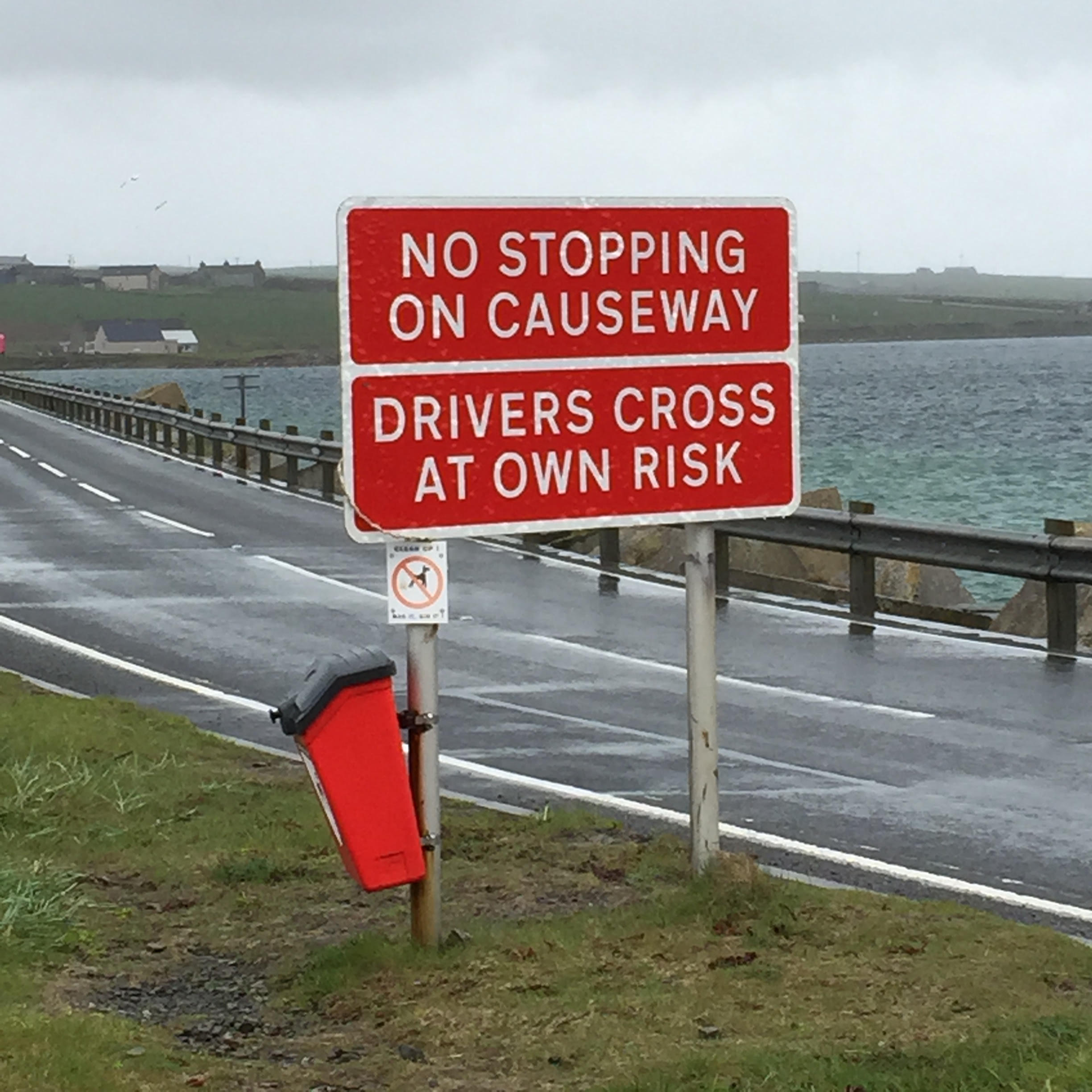
Five days later, Churchill reported to the War Cabinet that it had definitely been established that Royal Oak had been sunk by torpedo, but that “No definite report had been received as to how the submarine had got into Scapa.”3 On 28 October, however, Churchill reported to the War Cabinet that he had now received
the report from Admiral Drax and that there could be no doubt that the U-boat in question had passed through one of the unguarded entrances. The conversation concluded that a report would have to be made to the House of Commons, and while it would have to be admitted that the anchorage at Scapa had been unsafe against submarine attack, Churchill was to emphasise that necessary defences were being provided.
The Problem
So now the onus was on Churchill to ensure that remedial measures were instigated. As he later wrote, “On October 31, accompanied by the First Sea Lord, I went to Scapa….The scale of defence for Scapa upon which we now agreed included reinforcements of the booms and additional blockships in the exposed eastern channels, as well as controlled minefields and other devices….It was hoped that all these arrangements could be completed, or at least sufficiently advanced to justify the return of the Fleet by March, 1940.”4
On 13 November 1939 Churchill wrote to Admiral Pound, “Let me have a full report of what has been done at Scapa since the Royal Oak was torpedoed a month ago. What is the state of the booms and blockships at all entrances? What orders have been given to bring them up to the highest efficiency? What is the programme by which this is to be achieved?”5
After receiving an update, Churchill wrote to Pound on 21 December, “This is a very depressing report, and everything seems to be progressing very slowly and with immense difficulty. Pray let the Naval Staff consider what way we can speed up matters…. Why is it that nothing can be done about the blocking of the channels?…It is only by constant driving from the Admiralty that the many difficulties of the season and the darkness will be overcome.”6
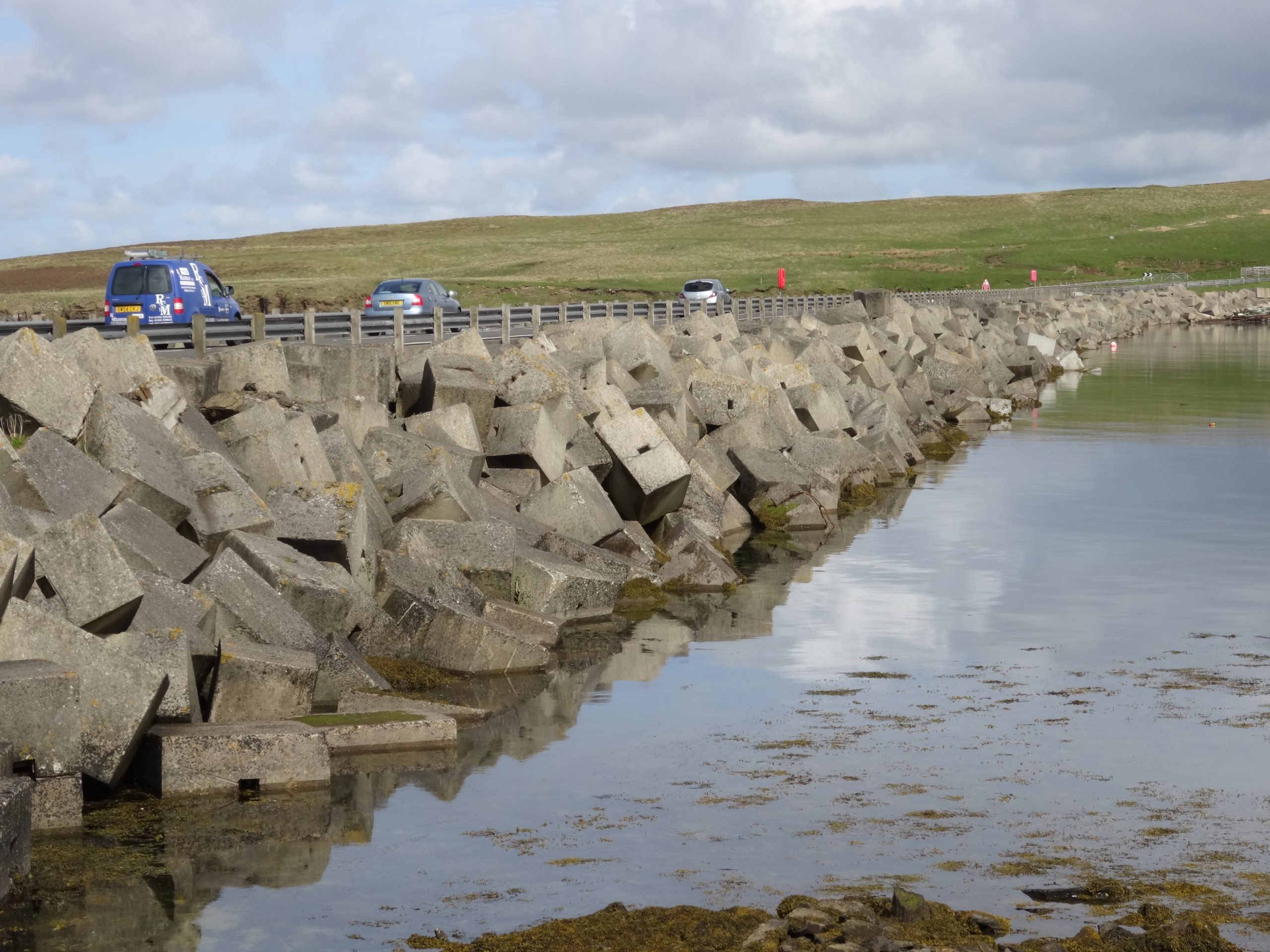
Churchill’s frustration with the slow progress is evident in a further note to Pound on 1 January 1940, “Two and a half months have passed since the Royal Oak was torpedoed. What in fact has been done since? How many blockships sunk?…Up to the present I share the Commander-in-Chief’s anxieties about the slow progress of this indispensable work.”7
In spite of the winter weather a Glasgow firm, Metal Industries Limited, was employed in sinking blockships; with the strong currents in the channels and bad weather, however, problems were encountered: “Even those which did arrive at their final destination did not always stay put. The Cape Ortegal for instance rolled over and broke up during a storm, leaving a navigable channel open once again through Skerry Sound….During one storm in February 1940 one blockship already in position was swept away and yet another was lost on passage to the Flow.”8
The Decision
Churchill could not risk another Royal Oak disaster. On 9 March 1940 he visited Scapa Flow again and met the Commander-in-Chief of the Home Fleet, Sir Charles Forbes, who shared his concerns. The minutes of the meeting included for the first time a documented reference to a major planned improvement in the protection to the Home Fleet in Scapa Flow, although the substance of the conversation indicates that this had been discussed previously:
FIRST LORD: Mentioned the scheme for permanently closing the Eastern Entrances.
ADMIRAL FORBES: Agreed that this was necessary and pointed out that Scapa will always be of permanent value as a Fleet Base from a strategical point of view.
FIRST LORD: Then asked when work could begin on sealing the Neuchatel [a blockship which had been sunk in Kirk Sound one week after the Royal Oak had been torpedoed] gap.
ADMIRAL FORBES: Replied within a month of receiving approval.
FIRST LORD: Stated there was universal agreement that the gaps should be closed permanently.9
Upon his return to London two days later, on 11 March, Churchill reported to the War Cabinet that “a great deal of work had been done to make Scapa a safe anchorage, and although there was still further work to be done, he thought that the base could now be considered 80 per cent secure. Strong anti-submarine patrols were being maintained outside all the entrances and the risks of using the anchorage in its present state were not greater than could properly be accepted.”10
Although on 12 March 1940 the Home Fleet returned to Scapa Flow, Churchill was still determined to improve the 80% security to 100%. Accordingly he approached the Civil Engineer-in-Chief to the Admiralty, Frederick Arthur Whitaker, and asked him if it was possible to seal the channels completely. Whitaker responded that it could be carried out, but it would be costly. Churchill’s reaction was that money was no object in the need to protect the Fleet fully. While it may be thought that Churchill should have advised the War Cabinet of his intentions, a firm decision could not be made until a feasibility study had been conducted.
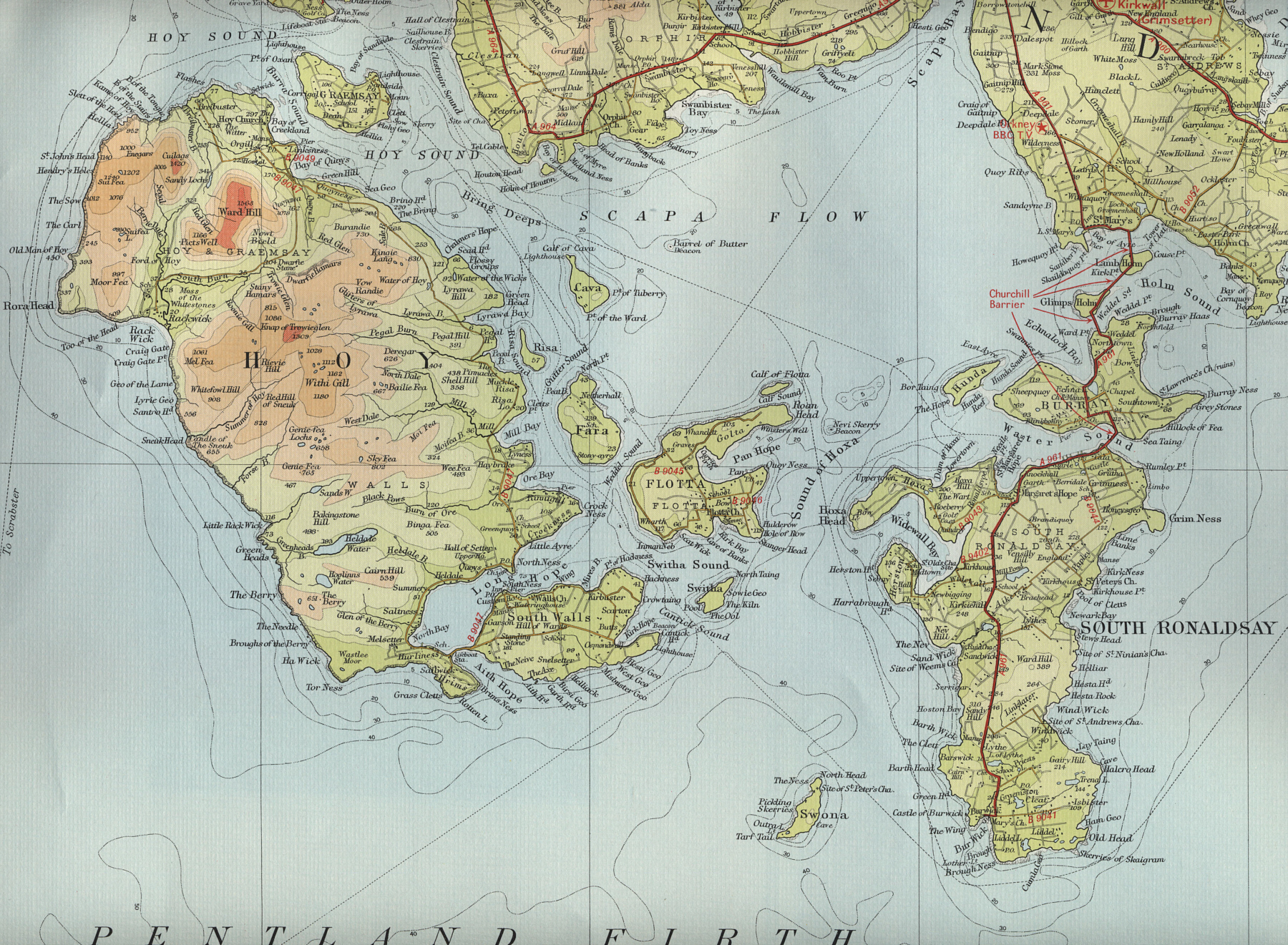
The Solution
The challenge was to close the four tidal channels located between the Eastern Mainland and the island of South Ronaldsay, via the islands of Lamb Holm, Glimps Holm, and Burray. Three channels were 609 metres (2,000 feet) long, with one 430 metres (1,400 feet) long: thus a total length of 2,257 metres (7,400 feet or 1.4 miles). Maximum depths were between thirty-eight feet and fifty-nine feet. But the size of the project was not the only problem; there were the tides, with a rise and fall of up to twelve feet, and a maximum current of twelve knots.
Whitaker was directed to design the project, and two scale models were built in the Whitworth Engineering Laboratories at the University of Manchester, with experiments conducted during the summer of 1940.
The preliminary work concluded that for the materials loose rubble would be used and contained in wire bolsters or gabions. The bolsters were be protected by massive concrete blocks. Tipping from barges was originally considered but found not to be feasible. The answer came in employing overhead cableways.
With the feasibility established, Churchill made the decision to proceed. Although it was a major undertaking, it is most interesting that he did not include a reference to it in his war memoirs, even thought he had given considerable space to the problems at Scapa Flow. The contract to build the barriers was awarded in 1940 to the firm of Balfour, Beatty & Co. Ltd., which later was employed on the two Mulberry Harbours built for the Normandy invasion. A Scottish firm, John M. Henderson & Co, Ltd., which had built the first cableway in the United Kingdom seventy years before, was chosen as the manufacturer of the cableways.
A further challenge was to find some 2,000 workmen for the project, when other services required manpower. The proposed answer, for the main part, came in looking to an enemy—1,300 Italian prisoners of war, captured in the North African Desert, who were interned in two prisoner of war camps—Camp 34 on Burray, and Camp 60 on Lamb Holm. The leaders of the POWs, however, not only refused to undertake the work but demanded that the camps be moved to safer locations, in view of the danger of being so close to the fleet’s home base. This request was refused, and both camps went on strike, which action resulted in changing the prisoners’ diet to bread and water.
A new commander, an Italian-speaking British major, was assigned to the POW camps. With great diplomacy he gained the trust of the prisoners and had the troublemakers removed to other facilities. He also countered the objection of asking prisoners of war to undertake war work—which was banned under the Geneva Convention—by putting it to the Italians that linking the four islands to the main Orkney Island was really a civilian project. This explanation was accepted, and the Italians agreed to work on the causeways.
The Construction
With the detailed planning required, actual construction work was not started until August 1941, when the five cableways were installed. The cableways were nicknamed “Blondins” after the French tight-rope walker, famous for his high-wire crossings of Niagara Falls. The one with the longest span measured 2,550 feet across, between its 172 foot masts. The cables themselves were of 2½ inch diameter and could take loads of up to 10¾ tons. With the “Blondins” installed the causeways could be filled. The mammoth project required dropping into the channels 125,000 dumpings of bolsters, containing 250,000 tons of quarried rubble, overlaid by 66,000 concrete blocks.
By the end of 1942 the work had reached a point where there was no longer a concern that submarines could enter the Flow from the eastern approaches, and a few months later surface craft were also denied entry—a remarkable achievement in such a short period of time.
The work continued, and by 1944 there were three and a quarter miles of new roads, bringing formerly separate communities closer together. The cost was estimated to be almost £2.5 million (the equivalent of some £100 million today). The First Lord of the Admiralty, A. V. Alexander, officially opened the road network on 12 May 1945, just after V-E Day.
The Legacy
With peace restored, there came an assessment of the project. The Orcadians were naturally thrilled that four of their islands, which previously could be reached only by water, could now be traversed by road. A formal Admiralty dossier on the project took another view, however: “The causeways are a magnificent engineering feat; but it may be considered that their construction proved, due to the large amount of wartime labour and shipping required, an uneconomical scheme of defence.”11 Ah, the benefit of hindsight!
While Scapa Flow, since 1957, has no longer been home to the British Navy, it is now a popular tourist location. The most visited site is the beautiful Italian Chapel, built by the prisoners, on Lamb Holm; there is also the Lyness Interpretation Centre, which chronicles the history of the base during both World Wars, and—close by—the Naval Cemetery, which houses the graves of those who died on HMS Royal Oak. The specific point where the ship sank is marked by a memorial buoy. In 1957 the Admiralty invited tenders for the ship. There was, though, such a public outcry that the Admiralty backed down, and the remains of the Royal Oak were designated as an official War Grave.
Terry Reardon is author of Winston Churchill and MacKenzie King: So Similar, So Different (2012).
Endnotes
1.Winston S. Churchill, The Gathering Storm (Boston: Houghton Mifflin, 1948), pp. 489–91.
2. Martin Gilbert, ed., The Churchill War Papers, Volume 1, At the Admiralty, September 1939–May 1940 (New York: Norton, 1993), p. 261.
3. Ibid., p. 281.
4. Churchill, p. 492.
5. Gilbert, p. 364.
6. Ibid., p. 551.
7. Ibid., p. 594.
8. W. S. Hewison, This Great Harbour, Scapa Flow (Edinburgh: Birlinn, 2005), p. 242.
9. Gilbert, pp. 862–63.
10. Ibid., pp. 867–68.
11. Hewison, p. 274.
Subscribe
WANT MORE?
Get the Churchill Bulletin delivered to your inbox once a month.
